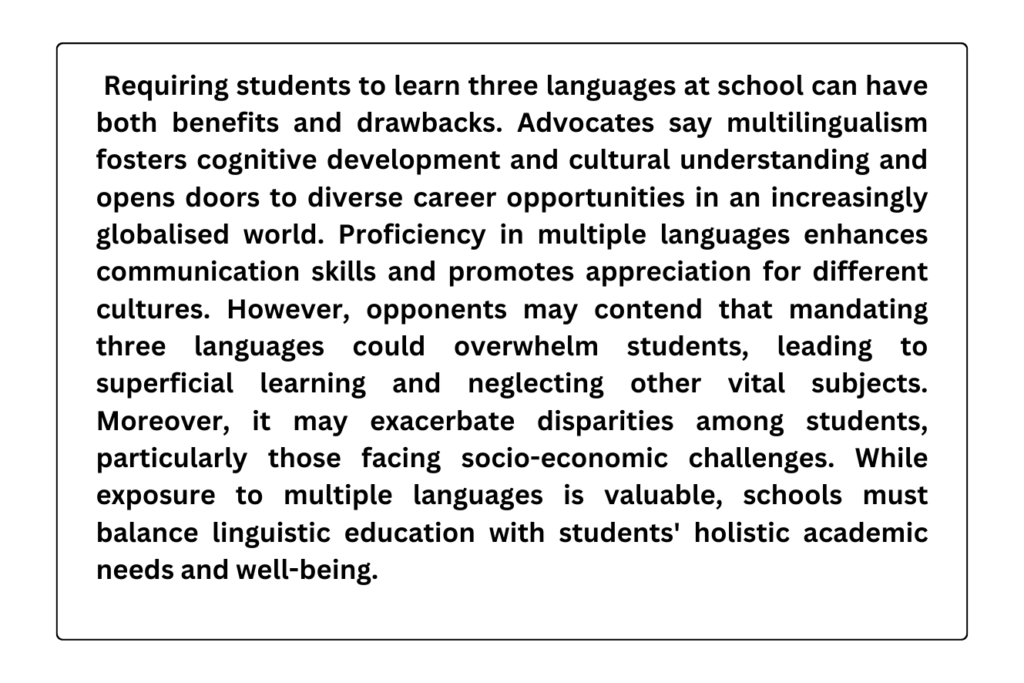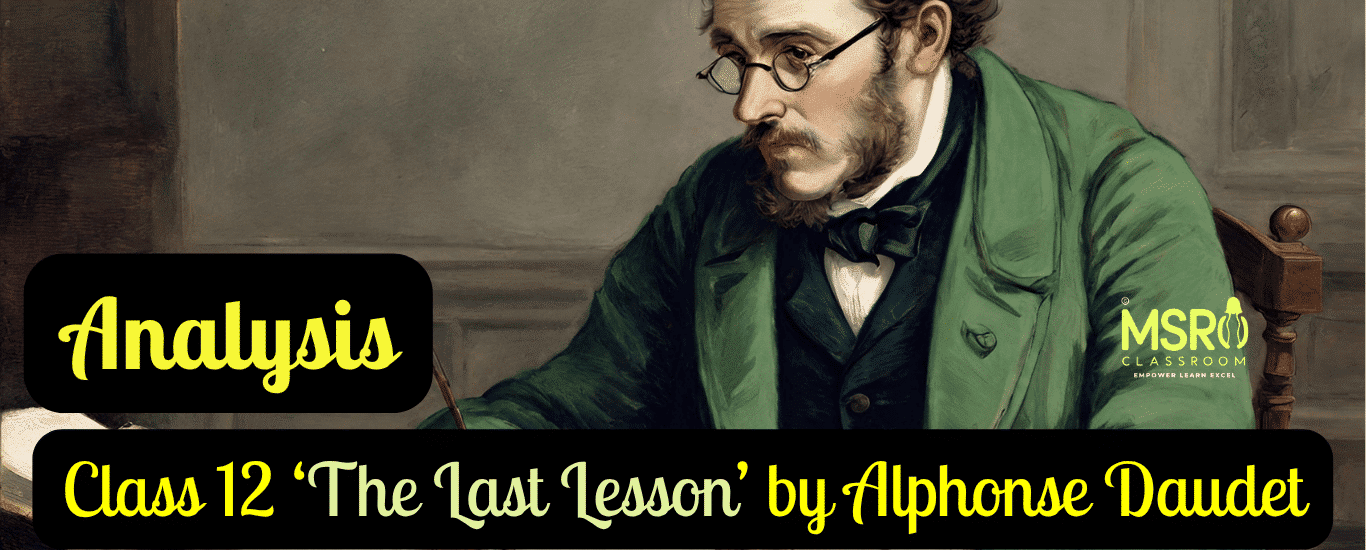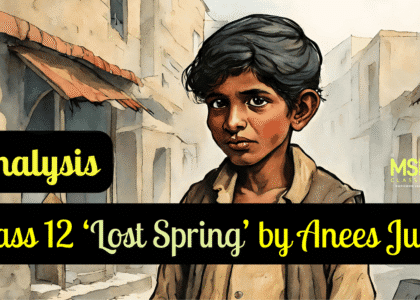Chapter 1-Alphonse Daudet’s “The Last Lesson” Summary, MCQs, Theme, Word Meanings, Textbook Questions/ Answers.
Chapter 1- The Last Lesson by Alphonse Daudet:
Table of Contents
Next on Flamingo: Chapter 2 “Lost Spring” Anees Jung
Summary ‘The Last Lesson’ by Alphonse Daudet:
‘The Last Lesson’ by Alphonse Daudet portrays the poignant final moments of French instruction in a small village in Alsace during the Franco-Prussian War (1870-1871). The protagonist, Franz, arrives late to school, unaware of the grave announcement awaiting him.
M. Hamel, the beloved teacher, reveals that German will replace French in Alsace-Lorraine schools. M. Hamel delivers his last lesson in a bittersweet culmination, emphasising preserving the French language and culture. He regrets missed opportunities and bids farewell with a powerful declaration of national pride.
The chapter captures the collective sorrow of losing language and identity amidst political upheaval, leaving an indelible impression on Franz and the community. M. Hamel’s final act symbolises defiance and resilience in the face of cultural erasure.

Shop: MSRO SMART NOTES: Class 12 English Literature
Theme ‘The Last Lesson’ Alphonse Daudet:
Central Theme:
Linguistic Suppression Under Foreign Rule:
- Cultural Erasure through Language Policies: Prussian authorities mandated German as the sole language of instruction in Alsace and Lorraine, erasing French linguistic and cultural heritage.
- Psychological Impact on the Population: Forcing a foreign language can damage people’s linguistic rights and cause psychological distress. Franz, the protagonist, regrets not being able to fully master his native language due to the sudden end of his French education.
- Resistance and Resilience: The community shows resilience and solidarity despite linguistic oppression. M. Hamel’s dedication to teaching French symbolises resistance against cultural assimilation. The villagers’ silent acknowledgement of his final lesson highlights their determination to preserve their heritage under foreign rule.
Sub-Theme:
Student and Teacher Perspectives on Education:
- Student Attitudes Towards Learning: Franz initially dislikes studying and prefers outdoor activities. However, his experiences made him realise the importance of education and cultural heritage.
- Teacher Dedication and Passion for Teaching: M. Hamel embodies unwavering dedication and passion for teaching despite the challenging circumstances imposed by foreign rule. His commitment to his students and subject matter is evident in his meticulous preparation for the final lesson and his poignant reflections on the significance of language and culture. M. Hamel’s dedication is a powerful example of the transformative impact that passionate educators can have on their students’ lives.
Explanation of ‘The Last Lesson’ for Auditory Learners:
Duration: 7 Minutes
Captions/subtitles available.
Character Sketches ‘The Last Lesson’:
1. Character Sketch of Franz:
Franz is the central character and protagonist in “The Last Lesson” by Alphonse Daudet. Here’s a character sketch of Franz:
- Young and Relatable: Franz is a young schoolboy, likely in his early teens, living in a village in Alsace during the Franco-Prussian War. He represents the innocence and vulnerability of youth and the typical struggles and distractions that come with adolescence.
- Initial Indifference to Education: At the story’s beginning, Franz is portrayed as somewhat indifferent to his studies. He dreads going to school, particularly when faced with the prospect of being questioned on participles, a subject he has not mastered. Instead, he finds the allure of outdoor activities and the warmth of the weather more appealing.
- Transformation and Growth: As the narrative progresses, Franz undergoes a significant transformation. Realising that his French lessons ended abruptly due to the Prussian decree, he experienced deep regret and loss. This moment catalyses Franz’s growth as he begins to recognise the value of his cultural heritage and the importance of education.
- Empathy and Compassion: Franz exhibits empathy and compassion towards his teacher, M. Hamel, despite his initial apprehensions, distractions, and the gravity of his community’s situation. He feels genuine sorrow and regret for not paying more attention in class and taking his education for granted.
- Symbol of Resilience: Franz emerges as a symbol of resilience and cultural preservation. His journey from indifference to awareness highlights the strength of individuals in the face of adversity and the enduring power of language and culture.
Franz’s character development in “The Last Lesson” highlights themes of youth, growth, resilience, and the importance of cultural identity in the face of linguistic suppression.
2. M. Hamel:
M. Hamel is a central character in “The Last Lesson” by Alphonse Daudet. Here’s a character sketch of M. Hamel:
- Dedicated Educator: M. Hamel is portrayed as a reliable and passionate educator who takes great pride in his profession. Despite knowing that his tenure as a teacher is ending due to the Prussian decree, he remains committed to imparting knowledge to his students until the end.
- Compassionate Mentor: Throughout the story, M. Hamel demonstrates compassion and understanding towards his students, including Franz, despite their occasional lack of diligence or interest in their studies. He recognises his students’ challenges and seeks to inspire them to appreciate the value and cultural heritage of education.
- Symbol of Cultural Preservation: M. Hamel symbolises cultural preservation and resistance against linguistic suppression. His unwavering dedication to teaching French language and literature, even in the face of oppressive language policies imposed by the Prussian authorities, highlights his commitment to preserving the cultural identity of his community.
- Reflective and Philosophical: As M. Hamel delivers his final lesson to his students, he reflects on the significance of language and education, imparting wisdom and insight that extends beyond the confines of the classroom. His reflections highlight the enduring power of language as a vehicle for cultural expression and identity.
- Emotional Depth: Despite his composed demeanour, M. Hamel’s emotional depth is evident in his final moments with his students. His palpable sadness and sense of loss at leaving behind his students, school, and homeland evoke empathy and resonance with the reader.
M. Hamel’s character in “The Last Lesson” embodies dedication, compassion, resilience, and cultural pride. He leaves a lasting impression on his students through his actions and teachings. He serves as a poignant reminder of the importance of education and cultural heritage in the face of adversity.
Textbook Questions/Answers “The Last Lesson” Alphonse Daudet:
Think As You Read:
Q1: What was Franz expected to be prepared with for school that day?
A1: Franz was expected to be prepared with knowledge about participles for school that day.
Q2: What did Franz notice that was unusual about the school that day?
A2: Franz noticed that the school was unusually quiet that day, unlike the usual bustling atmosphere at the beginning of a school day.
Q3: What had been put up on the bulletin board?
A3: On the bulletin board, news had been posted about the order from Berlin to teach only German in the schools of Alsace and Lorraine.
Q4: What changes did the order from Berlin cause in school that day?
A4: The order from Berlin caused significant changes in school that day, particularly the cessation of French language instruction. It was announced that the new mandate required teaching only German in the schools of Alsace and Lorraine.
Q5: How did Franz’s feelings about M. Hamel and school change?
A5: Franz’s feelings about M. Hamel and the school changed from initial apprehension and indifference to profound sadness and regret. He realised the value of his education and the impact of losing his French language and culture under the new Prussian rule. His appreciation for M. Hamel grew as he understood the depth of the teacher’s dedication and the significance of their final lesson together.
Understanding The Text:
Q1: The people in this story suddenly realise how precious their language is to them. What shows you this? Why does this happen?
A1: The realisation of the preciousness of their language is evident in several ways throughout the story:
- M. Hamel’s emotional farewell emphasises the importance of the French language, highlighting its beauty, clarity, and significance as a symbol of their identity and heritage.
- The villagers’ presence in the classroom during M. Hamel’s final lesson expresses their respect and regret for not valuing their language and education more
- Franz realises the value of his education and language, as he regrets not paying more attention and laments the loss of his French lessons under Prussian rule.
This realisation occurs due to the sudden imposition of teaching only German in the schools of Alsace and Lorraine by the order from Berlin. The threat of losing their language and cultural identity prompts the characters to recognise the significance and preciousness of their French language.
Q2: Franz thinks, “Will they make them sing in German, even the pigeons?” What could this mean? (There could be more than one answer.)
A2: Franz’s thought, “Will they make them sing in German, even the pigeons?” reflects his absurdity and disbelief about the forced imposition of German language and culture. It symbolises the pervasive impact of the Prussian decree on every aspect of their lives, even extending to their environment’s natural sounds and elements. It highlights Franz’s fear and uncertainty about losing their language and cultural identity under Prussian rule.
Talking About The Text:
Q1: “When a people are enslaved, as long as they hold fast to their language it is as if they had the key to their prison.” Can you think of historical examples where conquered people had their language taken away from them or imposed a language on them?
A1: Examples in history where conquered people had their language taken away from them or had a language imposed on them include:
- During European powers’ colonisation of various regions, indigenous languages were often suppressed or replaced with the colonisers’ language. For instance, Spanish imposition in Latin America, English imposition in many parts of Africa and Asia, and French imposition in parts of Africa and Southeast Asia.
- Throughout history, Persian language and culture were imposed on conquered territories and subjected peoples during various periods of Persian expansion and dominance, such as the Achaemenid, Sassanian, and Safavid empires. This occurred in present-day Afghanistan, Central Asia, and the Indian subcontinent.
Q2: What happens to a linguistic minority in a state? How do you think they can keep their language alive? For example, Punjabis in Bangalore, Tamilians in Mumbai, Kannadigas in Delhi, and Gujaratis in Kolkata
A2: A linguistic minority in a state may face challenges in preserving and promoting their language due to linguistic assimilation, cultural dominance, and limited opportunities for education and communication in their language. To keep their language alive, linguistic minorities can
- Establish community organisations and cultural centres dedicated to preserving and promoting their language.
- Advocate for bilingual education programs in schools and universities.
- Use digital platforms and social media to create and share content in their language.
- Encourage intergenerational transmission of language through family communication and cultural practices.
- Celebrate cultural festivals and events that highlight their language and heritage.
Q3: Is it possible to carry pride in one’s language too far? Do you know what ‘linguistic chauvinism’ means?
A3: It is possible to carry pride in one’s language too far, leading to linguistic chauvinism. Linguistic chauvinism refers to an excessive or extreme pride, superiority, or intolerance based on one’s language or linguistic identity. It can manifest in various ways, such as
- Believing that one’s language is superior to others and denigrating speakers of other languages.
- Opposing bilingualism or multilingualism and advocating for linguistic homogeneity.
- Using language as a tool for discrimination or exclusion against linguistic minorities.
- Resisting linguistic diversity and attempting to impose one’s language and culture on others. Promoting pride in one’s language and culture is important while respecting and appreciating linguistic diversity and the rights of speakers of other languages.
Working With Words:
Q1: English is a language that contains words from many other languages. This inclusiveness is one of the reasons it is now a world language.
Find out the origins of the following words.
- Tycoon – Japanese: The word “tycoon” originates from the Japanese term “taikun,” which means “great lord” or “prince.”
- Barbecue – Taino: The word “barbecue” comes from the Taino indigenous peoples of the Caribbean, who used the term “barbacoa” to refer to a wooden structure used for cooking meat over an open fire.
- Zero – Arabic: The word “zero” comes from the Arabic word “sifr,” which means “empty” or “zero.”
- Tulip – Persian: “Tulip” originates from the Persian word “dulband,” which means “turban,” likely referring to the shape of the flower.
- Veranda – Hindi: The word “veranda” comes from the Hindi word “varanda,” which means “enclosed porch” or “roofed platform.”
- Ski – Norwegian: The word “ski” comes from the Norwegian word “ski,” which refers to a long, narrow piece of wood used for gliding over snow.
- Logo – Greek: “Logo” derives from the Greek word “logos,” which means “word” or “reason.” In modern usage, it refers to a symbol or graphic representation of a company or organisation.
- Robot – Czech: The word “robot” comes from the Czech word “robota,” which means “forced labour” or “drudgery.”
- Trek – Afrikaans/Dutch: “Trek” comes from Afrikaans and Dutch, meaning a journey or migration, especially by the Boers in South Africa.
- Bandicoot – Telugu: “Bandicoot” comes from the Telugu word “pandi-kokku,” which refers to a specific species of Indian rat.
Q2: Notice the underlined words in these sentences and tick the option that best explains their meaning.
(a) “What a thunderclap these words were to me!”
The words were
(i) loud and clear.
(ii) startling and unexpected.
(iii) pleasant and welcome.
(b) “When a people are enslaved, as long as they hold fast to their language it is as if they had the key to their prison” It is as if they have the key to the prison as long as they
(i) do not lose their language.
(ii) are attached to their language.
(iii) quickly learn the conqueror’s language.
(c) Don’t go so fast; you will get to your school in plenty of time. You will get to your school
(i) very late.
(ii) too early.
(iii) early enough.
(d) I never saw him look so tall.
M. Hamel (a) had grown physically taller
(b) seemed very confident
(c) stood on the chair
Noticing form:
Read this sentence
“M. Hamel had said that he would question us on participles.”
In the sentence above, the verb form “had said” in the first part is used to indicate an “earlier past”. This form of the verb is called the past perfect.
Pick out five sentences from the story with this form of the verb and say why this form has been used.
- “But, of course, that day everything had to be as quiet as Sunday morning.”
- Everybody looked sad; and Hauser had brought an old primer, thumbed at the edges, and he held it open on his knees with his great spectacles lying across the pages.”
- “But he had the courage to hear every lesson to the very last.”
- “It was because they were sorry, too, that they had not gone to school more.”
- “I had counted on the commotion to get to my desk without being seen…”
Writing:
Write a notice for your school bulletin board. Your notice could be an announcement of a forthcoming event, a requirement to be fulfilled, or a rule to be followed.
Sample Notice:

Q2: Write a paragraph of about 100 words arguing for or against having to study three languages at school
Sample Paragraph:

Q3: Have you ever changed your opinion about someone or something that you had earlier liked or disliked? Narrate what led you to change your mind.
Sample Narration:










